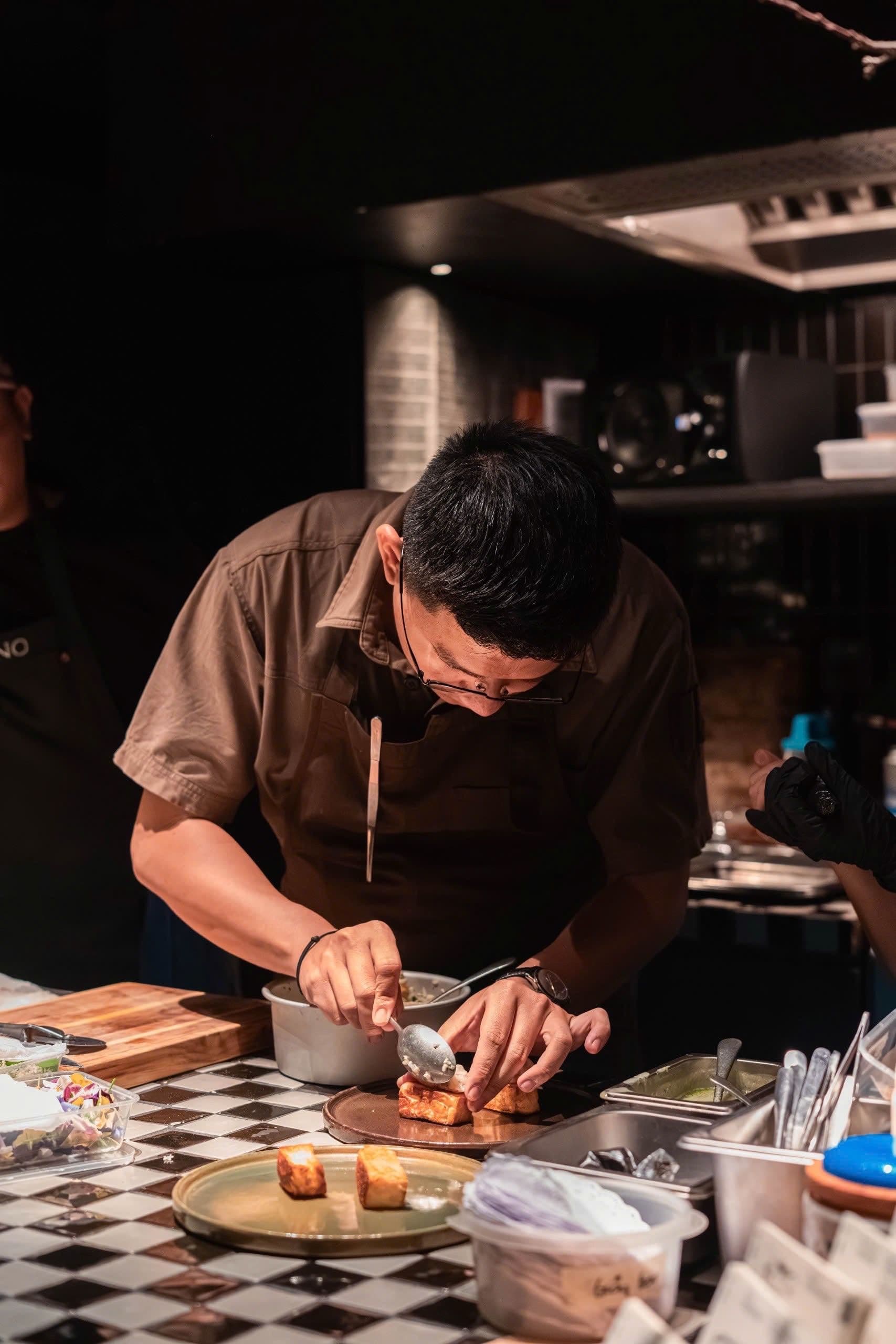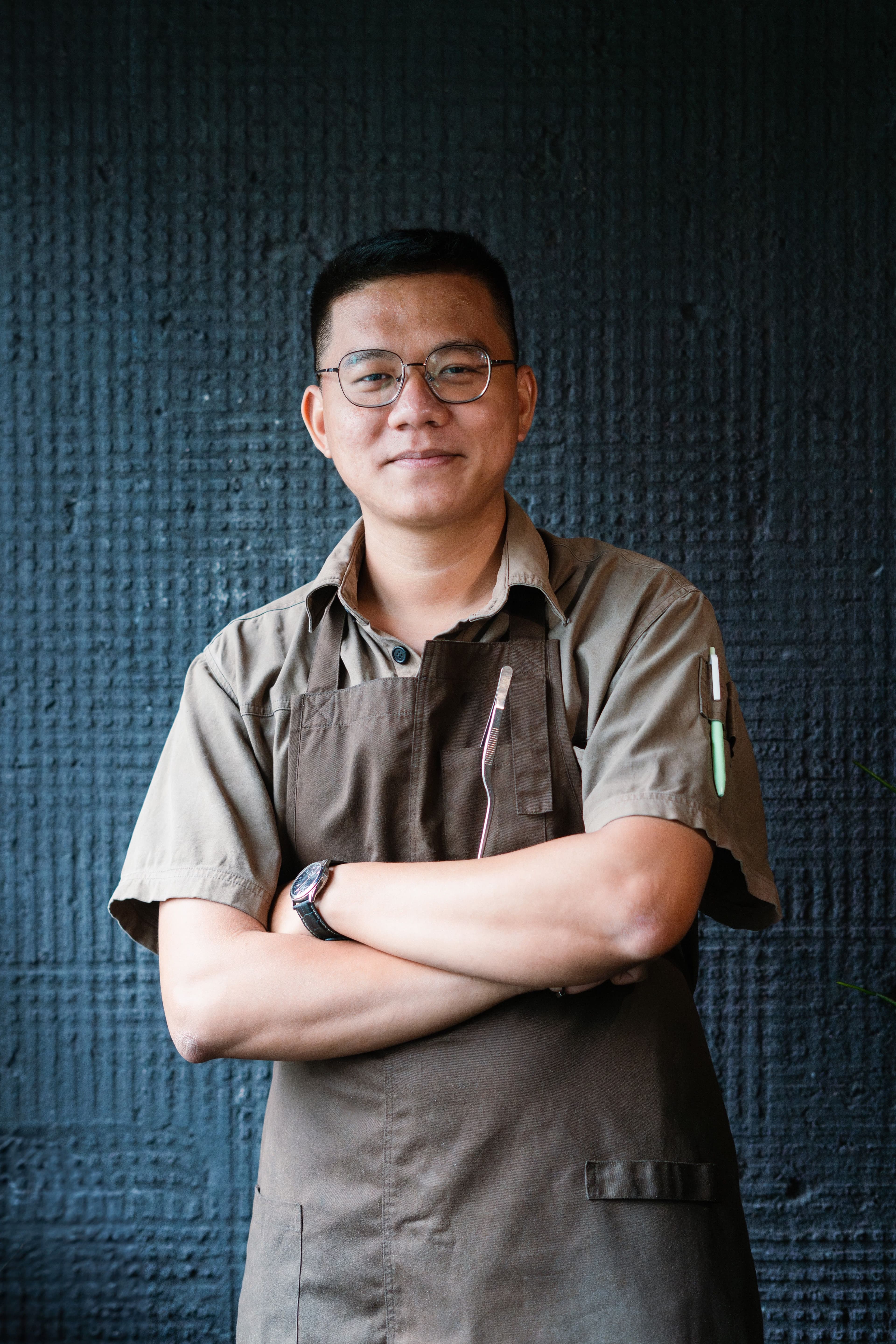Like any great chef, the first thing Đức did when we sat down to talk was offer me food – fresh, red Hanoian plums. And like any reasonable guest, I said yes and took a bite. It was juicy, tart, and telling. The sign behind my seat at his restaurant reads “Eating is healing” and it’s true. This fruit is healing my soul, I thought, my body feeling fresh out of the oven, still baking from the late afternoon heat. I take another bite, sink into my chair and begin to listen to the story of how Đức, head chef at Adau Kitchen, first fell in love with food.
“Be humble, be patient, work hard, and learn everyday.” This is the recipe of what makes a good chef according to Đức who has been working with food for over a decade. However, it’s the last part—learning everyday—that is the key ingredient. In Đức's case, this learning and curiosity in the kitchen go all the way back to his childhood.
Đức says some of his earliest memories were of his mom always trying to kick him out of the kitchen and him always wanting to stay. She used to say things like: It’s dangerous in here. This is not your area. Go away. And he would go away, for a while, but he would keep going back. The kitchen intrigued him. It’s where he wanted to be. It’s where his soul needed to be.
Soon the time to eat would come, the best time of the day, and Đức would sit down, eager for food. That is, unless it was time for fish. Đức does not like fish. He didn’t like it when he was young. He doesn’t like it to this day. The smell. The taste. The rawness. None of it. “Why don’t you eat the fish? The fish is good,” she would plead. “But I don’t like fish!” he would plead back. Those back-and-forth exchanges remain a core memory between the two.
However, after a while his mom had enough of it—she had to try a new tactic on her finicky child. So she decided she would cook venison and tell her son it was fish. “Mmm, this is really good! I like fish!” Đức started saying. The tables had turned—his mother’s clever ruse proved successful and the seed was planted. Đức now liked “fish” and from there his curiosity for food continued to ferment.

After high school, Đức went to university for a year, discovered it wasn’t for him, and dropped out. He was 18 years old and didn’t know what to do. It wasn’t until his mother reminded him of his early childhood memories and encouraged him to become a chef. So he enrolled at Sesame, also known as Ho Chi Minh City Restaurant Vocational School in Binh Thanh District. After he finished his program, he went on to work a number of jobs.
First, he worked at Sumo BBQ where he practiced preparing sauces. Next was New World Hotel where he worked for five years as a demi chef. After that he worked at Kiba Restaurant where his interest in the world of tapas, the best world might I add, called for him and where he met his mentor Pedro Goizueta, who is now the head chef and owner at Iberico - Tapas y Vino and Seed.eats in Hoi An. Đức says that while his mom was the one who inspired him the most, it was Goizueta who had the greatest impact in refining his skills. He worked there for a year as Commis Chef before being promoted to Sous Chef only for the restaurant to close a few months after. Following that, he got another Sous Chef job at another tapas restaurant called Lynd. He worked there for a year before it also closed. Then he worked in his third Sous Chef role at a third tapas restaurant, this one vegan, called Wild Thyme before it closed as well. Finally he found himself in his first head chef role at Adau Kitchen when it opened in 2021.
Now, roughly four years later, I’m chatting with him in his kitchen while the rest of the team members are preparing for dinner service. The crew includes Sous Chef Quý, Chef de Partie Thịnh, Commis Chef Thanh, and the two servers Linh and Bảo. And then of course there’s Đức who is in charge of creating the dishes and working with suppliers to get the right ingredients— including those Hanoian plums which are used for the kitchen’s balsamic vinegar dressing.
How does one approach creating a new dish, where do you even begin? For Đức, it begins with memory. Later on he builds the texture, constructs the flavor and explains the details to his team. For example, he tells me when he thinks of people living in Saigon, he thinks of kho quẹt, the caramelized fish sauce dip that was popular after the Vietnam War. He pulls out his phone and shows me a picture of the dish: “Xót Xa” which translates to heart aching and includes kho quẹt, rau đà lạt, and com gion.
Ironically, for someone who’s disliked fish his whole life, and a chef no less, Đức says this dish still feels like home.The caramelization doesn’t stop at transforming the sauce such that he loves the flavor—it rewrites the past, sweetening the memory of all of those back-and-forth moments between him and his mom from long ago. In other words, he uses his memories to create new memories with his guests and perhaps in the process reminds them of their own. It’s a way for him to share a part of himself and connect with others—it’s his favorite part about being a chef.
However, he knows that as a leader he can’t do everything himself. This is why he regularly consults with his team, asking them questions about their childhood and the different areas where they grew up. Quý and Thanh are from Long An, Thịnh’s from Bến Tre, Linh’s from Gia Lai, and Bảo’s from Khánh Hòa. I believe it’s this collective consciousness that allows Đức and his team, who have been together since the restaurant first opened, to create dishes that connect with others at a level deep in their psyche.
After all, food is more than just food. It doesn’t just nourish us, it transforms us. It can make you feel at home and make you miss home. It can make you feel like a grown-up and like a kid all over again. It can remind you of old memories and create new memories. Food can break you and heal you. When combined with memory and storytelling, food becomes an even greater experience. Such experiences pull us back into the past to rediscover what was and push us forth into the present to reimagine what’s possible. Like the process of healing, the curiosity to keep learning and experimenting never truly ends.
When I asked Đức what he is learning about now, what is keeping him interested, a big smile flashes across his face and before you know it he’s springing out of his chair saying “Fermentation.” He walks behind the counter and begins pulling big glass jars off the shelves and placing them in front of me—Eel garum, “Nhót HN”, eggfruit miso, and corn mắc khén miso. And in an instant, you don’t see the thirty-old-chef, you see a wide eyed kid in front of you, brimming with excitement and a willingness to share with you his latest science experiment in the kitchen. “The creative adult,” author Ursula K. Le Guin once wrote, “is the child who survived.” In that moment, and now etched in my memory, Đức is that child—still humble, still patient, still working hard, and still learning every day.
That said, I kept wondering, did he ever ask his mom about the whole venison thing? He laughed, “Yeah three four years ago.” “What happened?” I asked. He called his mom and she laughed too and said, “Now you know!” And now you know, the story of how Đức, head chef at Adau Kitchen, first fell in love with food and how he’s still discovering it, one memory, one experiment, one plum at a time.









